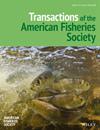在爱达荷州引进的布鲁克鳟鱼和幼鱼及溪流居民公牛鳟鱼之间的达尺度关联
IF 1.4
3区 农林科学
Q2 FISHERIES
引用次数: 0
摘要
摘要目的在不同的空间尺度下,当地鳟鱼种群可能受到多种压力因素的影响,使得生物与非生物控制的相对重要性难以在通常进行监测和管理的小尺度上区分。外来布鲁克鳟鱼在北美西部被广泛引进,对牛鳟的发生产生了负面影响。在这里,我们通过限制阈值的透镜研究了非本地布鲁克鳟鱼与幼鱼和溪流居民公牛鳟鱼(即250毫米)丰度之间的达尺度关联,其中非本地鱼类超过一定的鱼类密度可能会限制本地鱼类的丰度。方法:我们使用一个大的空间数据集来定义爱达荷州溪栖鳟鱼和小于250毫米的牛鳟通常共同出现的非生物条件。接下来,我们查询了在适合两种物种分布重叠的局部区域内的非生物条件下收集的多道电钓调查数据。然后,我们使用二维Kolmogorov-Smirnov测试来确定布鲁克鳟鱼密度的阈值,超过该阈值,小于250 mm的鳟鱼一直很少或不存在。结果在布鲁克鳟鱼密度超过0.54条/100 m 2的非生物条件下,小于250 mm的牛鳟很少或不存在。然而,布鲁克鳟鱼很少出现在与高鳟鱼密度相关的栖息地(例如,8月平均水温为8.2°C)。结论我们的研究结果支持了现有的假设,即牛鳟和溪鳟在适合两种物种的河流中长期共存可能是不稳定的。由于低密度的布鲁克鳟鱼似乎威胁到牛鳟鱼,需要进一步的研究来更好地了解驱动牛鳟鱼栖息地不断变化的范围和入侵动态的因素。我们提供了一个简单的工具来告知哪里布鲁克鳟鱼对牛鳟鱼构成主要威胁,并有可能应用于未来的监测、威胁评估和保护工作。本文章由计算机程序翻译,如有差异,请以英文原文为准。
Reach‐scale associations between introduced Brook Trout and juvenile and stream‐resident Bull Trout in Idaho
Abstract Objective Native Bull Trout Salvelinus confluentus populations can be influenced by a variety of stressors operating at multiple spatial scales, making the relative importance of biotic versus abiotic controls difficult to discern at small scales where monitoring and management typically occur. Nonnative Brook Trout S. fontinalis were widely introduced throughout western North America and negatively affect Bull Trout occurrence. Here, we examine reach‐scale associations between nonnative Brook Trout and juvenile and stream‐resident Bull Trout (i.e., <250 mm) abundances through the lens of a constraining threshold, where nonnative fish exceeding a certain fish density may constrain native fish abundance. Methods We used a large spatial data set to define the abiotic conditions in which stream‐dwelling Brook Trout and Bull Trout smaller than 250 mm typically co‐occur in Idaho. Next, we queried multipass electrofishing survey data collected in reaches with abiotic conditions suitable for both species within localized areas where their distributions overlap. We then used two‐dimensional Kolmogorov–Smirnov tests to identify threshold Brook Trout densities beyond which Bull Trout less than 250 mm were consistently rare or absent. Result Bull Trout smaller than 250 mm were rare or absent where Brook Trout density exceeded 0.54 fish/100 m 2 across the full range of abiotic conditions over which both species overlapped. However, Brook Trout rarely occurred in habitats associated with high Bull Trout density (e.g., where mean August water temperatures were 8.2°C). Conclusion Our results support existing hypotheses that the long‐term co‐occurrence of Bull Trout and Brook Trout in stream reaches suitable for both species may be unstable. Because low densities of Brook Trout appear to threaten Bull Trout, additional research is needed to better understand factors driving ongoing range shifts and invasion dynamics in Bull Trout habitat. We provide a simple tool to inform where Brook Trout represent a primary threat to Bull Trout, with potential applications for future monitoring, threat assessments, and conservation efforts.
求助全文
通过发布文献求助,成功后即可免费获取论文全文。
去求助
来源期刊
CiteScore
2.90
自引率
7.10%
发文量
48
审稿时长
8-16 weeks
期刊介绍:
Transactions of the American Fisheries Society is a highly regarded international journal of fisheries science that has been published continuously since 1872. It features results of basic and applied research in genetics, physiology, biology, ecology, population dynamics, economics, health, culture, and other topics germane to marine and freshwater finfish and shellfish and their respective fisheries and environments.

 求助内容:
求助内容: 应助结果提醒方式:
应助结果提醒方式:


